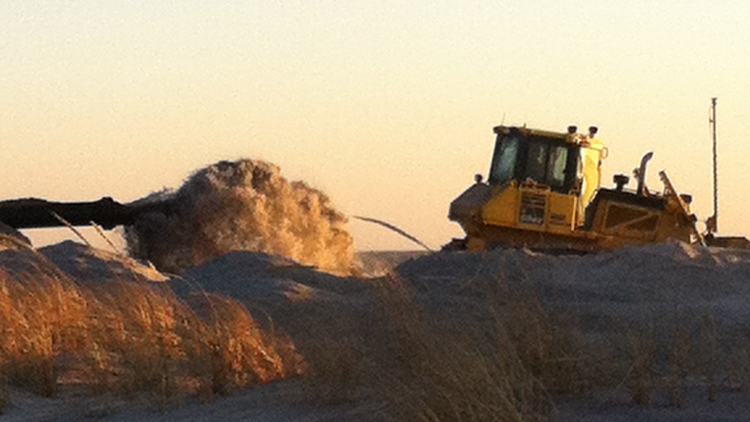A dredge crew pumps sand onto a Fire Island Beach in 2013.
Workers finally started this month a long-stalled $1.7 billion federal project to mitigate storm damage from the South Fork to Fire Island, more than a half century after the idea was proposed.
Officials recently applauded the start of the Fire Island Inlet to Montauk Point Project, known as FIMP for short, as crews prepared for the arrival of a dredge ship that will pump sand from the bottom of the ocean onto nearby beaches in the first of 11 contracts in the plan, which will also raise up to 4,400 structures.
“We don’t wan to talk about how long it has taken to get to this point,” Department of Environmental Conservation Commissioner Basil Seggos said during a Dec. 17 news conference at the Fire Island Lighthouse celebrating FIMP’s kickoff, before doing just that. “It has actually taken 62 years to get to this stage of this announcement. … Why? In large part because there wasn’t the political will. There also wasn’t the money.”
The project finally received the federal funding it needed to move forward thanks to the $50 billion Superstorm Sandy aid package that was enacted nearly a decade ago.
Suffolk County Executive Steve Bellone personified how it’s taken a generation for the plan to finally come together.
“I can guarantee you this is the first time and will be the last time I ever make this statement: I am thrilled to be attending today’s groundbreaking of a project initiated before I was born,” he said. “That will never happen again.”
He joked that the project is so complicated that its kickoff may have required divine intervention.
“I think you described it as a heavy lift,” Bellone said to Col. Matthew Luzzatto, commander of the U.S. Army Corps of Engineers’ New York District, who is overseeing the work. “I was thinking, miracle.
“Multiple local, state and federal agencies coordinating, that is a miracle,” he added. “That doesn’t happen. Ever.”
While the initial construction is 100% federally funded, that intergovernmental cooperation may later prove tricky when an additional $1.5 billion worth of future beach renourishment work intended to maintain the project will instead be split 50/50 between the federal government and New York State and local governments.
The U.S. Army Corps of Engineers awarded in August the first FIMP contract — a $47.5 million job — to the Houston-based Great Lakes Dredge and Dock Company, which will dredge the Fire Island Inlet and place the 1.4 million cubic yards of sand at Gilgo Beach State Park and Robert Moses State Park. The sand will be spread across about 10,000 linear feet of beach in each location, with berms and man-made dunes added.
“The whole operation is 24 hours a day, 7 days a week and we can move about 30,000 cubic yards of sand in a 24-hour period,” said Megan Place, a project manager for the dredging company. The work, of course, is dependent on weather and sea conditions.
Luzzatto said it was unclear when exactly the future contracts for work to be done east of the Moriches Inlet will get underway other than to say it will be at least two years from now.
“There’s two primary phases,” said Luzzatto. “There’s what we call the structural portion, which is the beach renourishments, the dune constructions, the dredging of the inlets. And then there’s the home elevations that we do and building protections that are done on a voluntary basis.”
Underscoring the significance of the announcement was the attendance of Maj. Gen. William H. Graham, the deputy commanding general for Civil and Emergency Operations for Army Corps projects nationwide — one of the top four commanders of the agency.
“We never thought this was possible, we never thought we would get to this day,” said Graham, who credited the project’s belated start to local officials and advocates “who for decades have been working diligently to understand the challenges that that sometimes angry sea poses to everybody who lives out here.”
Not everyone celebrated the news. Some say the money would be better spent relocating waterfront properties away from the impending threat of sea-level rise caused by climate change.
“Even Dark Age types knew better than to try and build something permanent on shifting sands along the coast,” said Steven Resler, a retired NY Department of State coastal manager who advocates a strategic retreat and selective fortification policy — not rebuilding beach homes lost to storms, but constructing a sea wall for lower Manhattan. “So did Long Island’s original settlers — the first ones, not the Europeans. Those original settlers visited and used areas of moving sands, but didn’t put their homes and villages there.”
Both Resler and Kevin McAllister, founding president of Sag Harbor-based environmental advocacy group Defend H20, have taken issue with the biological impacts of dredging 50-to-100-acre holes in the seafloor to pump the sand on the beaches and build dunes, which may set marine habitats back decades, if not longer.
“A losing prospect largely ignored by ‘keep it rosy’ elected officials and the sand industrial complex who benefits from continued community ignorance,” is how McAllister described beach renourishment projects. “Let’s avoid costly regrets. Start challenging folly beaches by asking the right questions.”
He suggested this one: “A choice to be made without further delay: the beach or the beach house?”
Attorneys for property owners who will be asked to provide for FIMP easements — a legal right of way allowing crews to perform work on private property — will likely have questions on behalf of some of the Hamptons’ wealthy oceanfront property owners. Hundreds of easements are required to advance the project. If negotiations break down, cases can go to court under eminent domain, the legal process in which the government acquires private property for public use.
Another question that remains outstanding is why the use of rock jetties known as groins appear to vary depending upon location. The argument against groins is that they starve beaches to the west of sand from what’s known as the littoral drift, or the natural flow of sand from east to west. In the Village of Ocean Beach on Fire Island, one of the FIMP contacts calls for removing or modifying two groins, but more than a dozen groins in the Hamptons leg of the project will remain in place.
The Army Corps did not provide a comment as to why that is as of press time.
Sign up for Long Island Press’ email newsletters here. Sign up for home delivery of Long Island Press here. Sign up for discounts by becoming a Long Island Press community partner here.
































